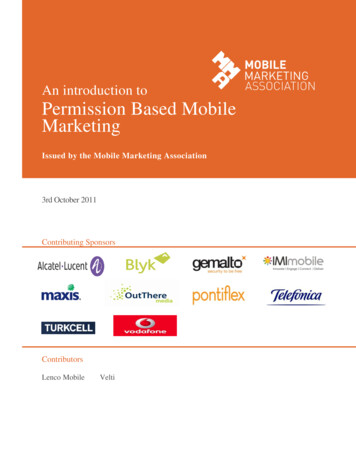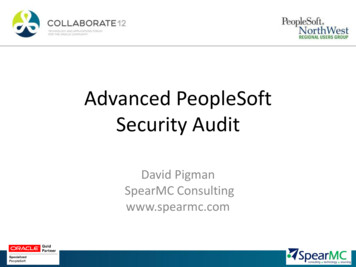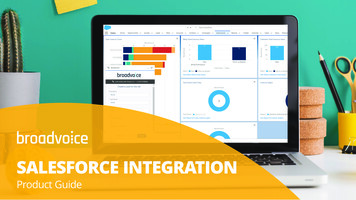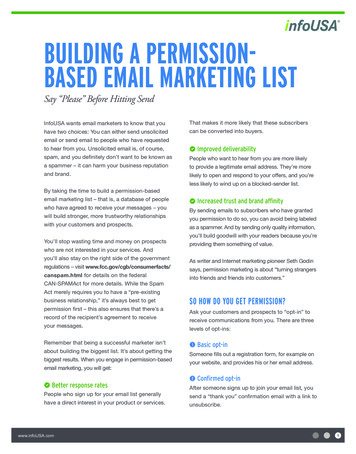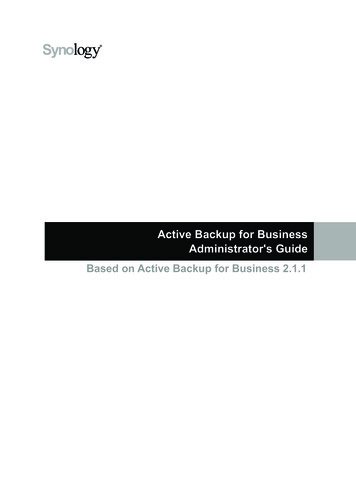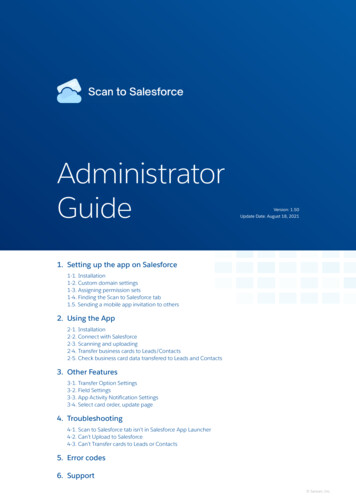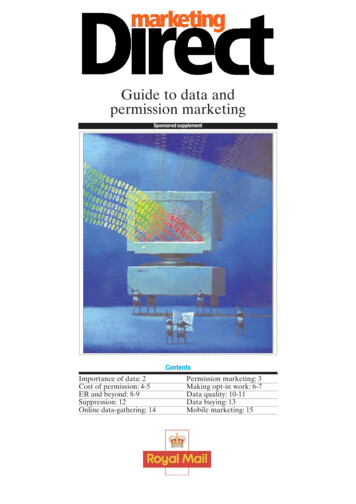
Transcription
Guide to data andpermission marketingSponsored supplementContentsImportance of data: 2Cost of permission: 4-5ER and beyond: 8-9Suppression: 12Online data-gathering: 14Permission marketing: 3Making opt-in work: 6-7Data quality: 10-11Data buying: 13Mobile marketing: 15
Sponsored supplementPerspective“Let’s talk about data. Mostmarketers’ eyes glaze over atthis point, but I don’t understand why.I’m not techie – just a marketing manpure and simple. So why are so manyof my colleagues put off by data?This attitude is at best anachronistic, at worstpotentiallydamaging. Inthese days ofone-to-onemarketing, ifyou’re not incontrol ofyour data,you’re not inRichard Rochecontrol ofyour marketing.Mindsets are oftenfocused on the ‘sexy issues’,including acquisition, prospectingand creativity, while the thinkingabout media selection and datausage is frequently outsourced.Thismeans marketers don’t have a fullunderstanding of data and its usewithin their organisation.They should make it a priority toacquire this knowledge becausefailing to understand the end-to-endprocess can result in missedopportunities, misinterpretation, poorreturn on investment (ROI) and poorresponse to campaigns.As a result of this lack ofknowledge, I see a state of anarchyapproaching the marketing industry.Many companies do not comply withthe Data Protection Act or any otherbest practice, which could bringbusinesses to a standstill as thesecodes enter law. More Europeanlegislation could drive us to an opt-insystem of one-to-one marketing,which would mean no more directmarketing without permission. If wehaven’t collected data on apermission basis and kept it up toscratch, then we could be in trouble.By using relevant, clean, goodquality data, communicationsbecome more relevant, timely andeffective, leading to an increase inmarketing ROI. Brands may beenhanced, more sales made, andwastage reduced through improvedtargeting.And all of these benefits arereadily available to those who areprepared to take the time tounderstand their data.”Richard Roche,director of datadevelopment,Royal MailSupplement published by:Haymarket PublicationsWords by: Peter Crush, NoelleMcElhatton, Ed Shelton, Holly AclandDPA brings home theimportance of dataData issues have been forced into the spotlight with the passing of UK and Europeanlaws on data privacy. Marketers have to tackle these issues sooner rather than laterData is information and, so thesaying goes,information is power.But are today’s marketers reallythe most powerful people in thecountry, exploiting the public totheir commercial gain?According to some in theGovernment and at civil libertiesorganisations, marketers havebeen exploiting their privilegedpositions for too long. Last October the requirements of the 1998Data Protection Act (DPA) camefully into force (see box, below).While not originally aimed at marketers, it has had massive implications, creating a bandwagon formore legislation that threatens to Direct Marketing Associationchoke an industry that believes in firmly believes in a system of optself regulation.ing out of marketing communications, in July the EuropeanDPA provisionsParliament finally passed itsThe provisions of the DPA call for Electronic Communications and‘clean’ data (although there is no Data Privacy Bill. Requiring thatdefinition of how often it must be all EU-wide emails and text mescleaned), and that any marketing saging are opt-in, permission isinformation is sent with the enforced in this channel,with marconsumer’s consent.This implies keters having until just Octoberpermission, although it is not as 2003 to set their houses in order.didactic as this, with the interpreBut what of its caveat that opttation being that anything not in is not required for existing cusopted-out of constitutes opted-in. tomers? How does one define anBoth permission and data qua- ‘existing relationship’? Will thelity are now among the most seri- ruling for email only quicken theous issues affecting marketers. In pace for putting opt-in regulationsthe first dedicated supplement of for direct mail?its kind, these next few pagesAs several public lists areadvance the implications of this already incorporating an opt-outsea change in marketing commu- option – the ER and Directors atnications. Permission marketing Home lists being the most notable(pages 6-7), the implications oflosing full access to the Electoral DPA in a minuteRoll (ER) (pages 8 and 9), andonline data capture (page 14) are Only necessary data should be held Individuals should know about thejust some of the areas covered.We gauge industry opinion to data held on thempermission-based marketing.Will Data should be accuratelegislation be enforced before the Data should be shown to thirdindustry has time to get its house parties only with the individual’sin order? And what will all this permission or with justificationmean for data quality? Will mar- Data must be available for theketers finally clean up their act individual’s inspectionand keep accurate and clean data? The individual may requestAlready both permission and amendment or destruction of the datadata quality have gained extra The reasons for holding the datacurrency as more laws are nipping should be explained to the individualat marketers’ heels. While the2– not only is the permission modelmaking prospecting activity moredifficult, but data quality is underthreat as well. The full ER – themainstay of the industry for validating address details – will not beavailable for list cleaning purposes, making it hard to comply withthe requirements of the DPA.Meanwhile,the new media marketing fraternity is already havingto get to grips with the EU ruling(see page 14).As the Government struggles todecide whether human rights arebeing breached by unsoliciteddirect marketing, far from beingthe less sexy side of marketing,data has never been more crucial.We start this supplement bylooking at permission – a smallword but one which has bigimplications.EU rules in a minute Opt-in for all unsolicited emailsacross the European Union Where an email address hasbeen acquired in a sales context,a company may send marketingemails for its own productswithout the prior consent of therecipient The use of cookies is opt-out butonly after ‘clear and comprehensive’information is provided on the‘benefits and limitations’ of thetechnology
Sponsored supplementPermission is now realityPermission marketing would seem ideally suited to the DM industry, ensuring that messages go straight to peoplewho want them. But the idea has been met with confusion and concern that marketing activities will be restrictedThe industry didn’t ask for it, but‘permission’ is here and it’s hereto stay. Seth Godin, whose seminal Permission Marketing bookon the subject was published twoyears ago, is partly responsible.Butit’stheformerInformation CommissionerElizabeth France who has madethis approach a commercial reality by pushing through the inclusion of an opt-out box on thisyear’s Electoral Roll canvasse(see feature, page 8).France doesn’t understand whythis is an issue for today’s marketers.“Direct marketers are constantly saying that they only wantto send DM to people who reallywant it,” she says.“Target, target,target is their mantra, so thereshould be no problem.”Recent legislation also demands that companies adopt a morepermission-based approach tomarketing. Earlier this year theEuropean Parliament voted foran EU-wide soft opt-in on unsolicted emails which has subsequently been approved by theCouncil of Ministers.It means thatwhere there is no existing rela-tionship,consumers must give prior consent to receive unsolicitedemails. But the terminology itselfis confusing with the term ‘existingrelationship’ open to different interpretations (see box,below).In fact, the concept of permission marketing generated a mixedresponse. One the one hand it hasbeen welcomed.After all, permission marketing places the individual’s needs and requests at theheart of a relationship – a centralplank of good direct marketing.The industry has always suffered from the perception of beingunwelcome and intrusive. By allowing consumers to dictate acompany’s communications strategy, permission marketing is notonly a logical extension of relationship marketing but is also amark of the credibility of the industry.On the other hand, there areplenty who feel that a purely permission-based direct marketingmodel will not work. Jon Ingall,managing director of agencyArchibald Ingall Stretton, goes asfar as to call it “commercial suicide”, picking up on a commonargument about the changingnature of an individual’s needs.“What didn’t interest them yesterday may be top of their prioritylist tomorrow.Consumers are fickle – they change their mind and it’stheir right to do so,”he says.“Mostpeople, for example, would tellyou they don’t want to receivedirect mail if asked.These are the“Direct marketers areconstantly saying that theyonly want to send DM topeople who really want it.Target,target,target is theirmantra,so there should beno problem”same people, presumably, whomake up the 80 per cent who havebought something through directmail at some point.”Of course, if the consumer feelsvery strongly about receivingdirect mail, there is always theoption of registering with theMailing Preference Service. Themajority of mailers run their dataagainst this file, effectivelyensuring that the doormats of theanti-mail lobby are not contaminated with direct mail.This represents a relativelysmall percentage of the population, which any marketer whodoesn’t want to alienate potentialcustomers should avoid at allcosts.But it’s the grey area – wherepeople have neither given norwithheld permission – which is acore audience for brand owners toreach. Direct marketers are rightly concerned that restricting theirmarketing universe to those individuals who have explicitly givenpermission would be a severelylimiting thing to do.Whether the tide is inevitablyturning to this approach remainsto be seen. Many believe it is onlya question of time before directmail becomes subject to opt-inregulations.In the mean time, companiesshould go the extra mile to provethat targeted,timely,impactful activity might actually be welcomedby consumers rather thanshunned.What is an existing relationship?What do you understand by permission?“Permission marketing implies thatan interested party has contacted orbeen contacted by a company andthat person has agreed to receivinginformation from them. It’sincreasingly being applied to theB2B sector, but I believe it shouldn’tbe such a big issue here.Asbusiness people we are, by definition,available to be contacted aboutbusiness-related issues at work.”Mike Gray,managing director,Conduit“There is no easy definition.What onemay think of as a relationship,theconsumer – or another firm – mightsee as a passing contact.We classpeople in terms of who buys ourproduct or people that have signed upfor more information.We try to getassurances from other list ownersthat their criteria is the same.”Helen Chester, internet marketingmanager, Kodak Digital and appliedimaging, EAMER“Permission is one of those ‘fine intheory, difficult in practice’ ideas.We’ve worked on the database for theBritish Heart Foundation for the pastten years.We hold 100,000 donornames, but on the acquisition side,operating in a permissionenvironment is almost impossible. Ireceive emails where I don’t knowhow I’ve been contacted, but I can atleast choose to opt-out.”Jonathan Maiden, managingdirector, DMS“My view is that there has to havebeen some trade taking place. If I wascommunicated to in a prospectingway this would not be so.This isambiguous though. I think theprospecting model should give theperson the opportunity to opt out.Wewill have to work within theguidelines and deploy opt-in lists,but realistically it won’t stopthe cowboys.”Philip Singh, head of ecommerce,Experian Marketing Services3
Sponsored supplementDo permissionPerspectiveSeth GodinSeth Godinhas beendescribed asthe king ofpermissionmarketing,and is authorof the bestselling bookPermissionMarketing.He gave ushis exclusivethoughts on the debate:Q: Why do marketers fearpermission marketing for mail?A: Direct marketers have two issues:they’re used to the established way ofdoing things and permission changeseverything. It’s also a lot more work.Q: Will opt-in put pressure on alldirect mail being subject topermission?A: It’s a no-brainer and the marketerswill be glad for it later. Opt-out isnothing but spam and it burnsrelationships, which is the only asseta direct marketer has.Q: If the industry doesn’t selfregulate in favour of permission,will it only be a matter of timebefore it is ‘forced’ to adopt thisthrough more legislation?A:You bet.Q: Are the legal arguments forpermission founded on reality? Dopeople really feel aggrieved bymail they haven’t asked for?A: Shoplifting is a crime, yet everytheft is tiny compared to the annualgross of Marks & Spencer. So why tryto stop small thefts? Because ifeveryone does it, the whole store isbankrupt.The same thing is true here.Q: Does permission stack up? Ifsomeone didn’t ask for mail oremail, but it’s been so welltargeted that they actually find ituseful, then is whether it wasasked for or not irrelevant?A:The fallacy of the serendipitousresult of spam is based on the law oflarge numbers. So what if we annoy1,000 people – one person was gladwe came along.A common argument citedagainst the introductionof the permission model isthat the cost of generatinga viable list of names fromit is prohibitive. But manyin the industry are keen torefute this – and they havethe statistics to back it upMixed feelings about permissionbased marketing has not dampened the spirits of several playersin the industry, all of whom areconvinced that this is the lastchance for the direct marketingindustry to shed its image as asender of spam and unwantedmail.Cost versus performanceOne of the corners they arefighting is the perception thatgood data – data that in theoryyields higher response – is moreexpensive data (see box, right).Because of the scarcity of opt-innames, it is presumed that thosethat do exist are pricier.Cost is relative though. If theperformance of opt-in names is somuch better, aren’t they worthpaying for?The most well-known opt-in listis the Postal Preference Service(PPS), which, according to KeithMcNeilly, CRM director at thePPS, now comprises 2.3 millionnames with a million more expected to be added by December.Consumers complete the PPSsurvey by ticking a ‘yes’, ‘no’ or‘don’t mind’ box to receiving mailin certain areas. The ‘no’ file be-comes an opt-out suppression filemarketed by The REaD Group,while the ‘yes’ responses generatea permission-based list availablefrom the PPS.The company claimsthis list can generate an uplift inresponse from anywhere between20-400 per cent.Its detractors argue that notenough yes responses are filled into enable PPS data to facilitatehigh volume, cost effective mailings – making it more of an optout suppression file rather than apermission list.In addition PPS numbers arebolstered through assumed ratherthan clear, overt permission.The‘don’t mind’ category, saysMcNeilly, constitutes“more of ayes than a no”to be marketed to.But the true story of PPS data isthat its cost is comparable withthat of other lists and clients are“It’s a myth that this datacosts more.The PPSsuppression file is arelatively cheap one in termsof royalty – just 10p a namecompared with the NationalSuppression File at 27p”4using the data – despite limitednames – with great success. ClaireBabraff, senior account managerat creative relationship marketingagency,Chemistry,works with thedatabase for the feminine hygienebrand,Bodyform.“Bodyform had its own database of about 180,000 records,”she says, “however we wanted tosupplement this by acquiring newrecords from relevant cold lists.Last year we did a test using PPSdata,mailing all those that had expressed an interest in the femininehygiene category. We were delighted when we got a 13 per centresponse, and we will consider using PPS data for future use.”The cost of the suppression element of PPS data comparesfavourably with other files on themarket, according to Gary Bettle,managing director of data bureau
Sponsored supplementcosts add up?“What’s never talked aboutare the cost benefits emailoffers.With traditional DM,you need a minimum of20,000 names.With emailyou can test 500 and see ahigher response”Data Direct.“It’s a myth that thisdata costs more,” he says. “ThePPS suppression file is a relativelycheap one in terms of royalty –just 10p a name, which compareswith the National SuppressionFile at 27p a record.”Email opt-in data is also vyingfor respectability from a performance and cost effectivenesspoint of view. Martin Kiernowskiis chief operating officer of IPT, aprovider of online data capturethrough two main products.The first is MyOffers, whereconsumers complete brand-sponsored questionnaires online,offering opt-in information in return for entry into prize draws.Thesecond is OK-mail, which provides emails to opted-in consumers on behalf of companies.Testing the watersTogether both hold one millionnames and addresses,with 400,000email addresses on top of that.More than 500 categories of interests have been opted-in to.“Companies are just dippingtheir toes into the water usingthese lists,” concedes Kiernowski.“It’s because of bad press aboutspam. In many ways I still thinkthe argument is more whether todo email marketing or not, ratherthan opt-in or opt-out,as most listsare opt-in to some degree or another.The industry is waiting forthe proof that it’s a real contender.“What’s never talked about,though, are the real cost benefitsthis medium offers,” he adds.“Remember,with traditional DMyou need a minimum of 20,000names.With email you can do statistically valid tests with 500 andsee higher response.”Royal Mail researchFear about the cost of permissionis one of the key concerns thatmarketers have about changesto the Data Protection Act (DPA),the Electoral Roll and the introductionof EU law, according to exclusiveresearch by Royal Mail andThe BPRI Group.According to the study, whichspoke to the UK’s top 2,000advertisers (whose combined directmail spend is a minimum of 49million), 61 per cent said they wouldmove away from personalised formsof DM because of these fears, with athird of one group of respondentssaying that permission would mean aserious increase in their costs.Alex Walsh, head of legislativedevelopment at Royal Mail MediaMarkets, says the research wasconducted to test how well theindustry was prepared for currentpermission legislation and a futureopt-in world. He believes the resultsconfirm that most in the industry areextremely worried.“The financesector was saying that if it couldn’tcross-sell, which the EU legislationalready makes it ambiguous to do, itwould affect its whole economies fordoing DM,”Walsh explains.According to the research, 37 percent thought changes to the DPAwere ‘quite negative’, with a further14 per cent saying they were ‘verynegative’. Only 17 per centspontaneously mentionedpermission/opt-in marketing as anissue, but after they were given adefinition of what permissionmarketing actually means, 52 percent said the debate was moreserious than they had thought.Thiscompares to only 45 per cent whosaid the threat was about the same.“As expected, marketers whohad the highest budgets thought apermission environment would havea larger negative impact than thosewith smaller budgets,” says Walsh.“What was interesting, however, wasthat many said it would force them toreduce mail volumes [27 per cent] butnot budget, indicating that they thinkcost is a major factor.”Of those who said they would beforced to change the level of DM theydo as a result of permission, 64 percent said they would first re-allocatefunds to press response advertising,with 36 per cent adding thattelemarketing would also increase.Significantly, only six per cent of allrespondents said permission-basedmarketing would reduce the ‘junkmail’ perception.“These are real concerns about thedegree of opt-in,” says Walsh.“In thenext few years data won’t be as5liberally available as it is now. It willforce marketers to come up withmore innovative ways of talking toconsumers.The real challenge formarketers is working out what youhave to offer people to opt-in.”He adds:“Harmonisation, withthe same rules for doing DM applyingthroughout Europe, will happen.Our arguments may well delay theprocess, but they will only do that– delay them. But a well preparedindustry shouldn’t have anythingto fear.”
Sponsored supplementSurveyHow to makeIt seems that marketerswill have to get to gripswith opt-in sooner ratherthan later. We asked threepeople from different partsof the industry whether themodel will actually workWe’ve heard about the regulations – current and impending.We’ve heard from the opt-inproviders and the doubters of thepermission model. We’ve heardfrom those who think it is absurdand those who think it is the onlysensible way ahead.One thing is for sure – this is atopic which stirs up strong viewson both the client and agency side(see boxes,below).But what about the all-important recipient – the consumer whoeveryone in the industry has aview on but whose voice is rarelyheard? Over the page we hearfrom Eileen de Bruin,a housewifewho scans and then throws away90 per cent of her mail and is a firmadvocate of permission-basedmarketing.But she adds an important proviso – that the companyshe gives her permission to sticksto the promises made.Open and transparent dealingswith the consumer are at the heartof permission-based marketing.And when a company really doescomply with a consumer’s requests it’s "a win-win situation"says Royal Mail director of datadevelopment Richard Roche."I’m not saying that this will beeasy, but if we can go down a permission route, 75 per cent of mailings could be relevant.This wouldbe in marked contrast to the number that are relevant today."It won’t of course be easy tomaintain a permission-baseddatabase once it has been established. For one thing, customers’needs and wants change overtime, which means a programmeof regular updating is essential.While information on a skiing holiday or a loan may be front ofmind one month, as soon as thatholiday is bought or the loan secured those preferences need tobe ‘de-activated’.Keeping up to date with an individual’s changing preferences isone of the real challenges theindustry faces if this approach is toThe client viewThe agency viewHuw DavisPermission can work if you get thebalance right.The key to success withopt-in marketing is ensuring that theoffer of future communications isclear and appropriate to the audiencebeing addressed.Often the opt-in wording is toovague or broad to really be of value.If a customer does not understandwhat they are opting in for, or whatthey will receive as a result of optingin, they are not making an informedchoice and are not necessarilyinterested in the specific product orservice.become a reality. As marketingdirector of E4 Rufus Radcliffepoints out, allowing recipients (orviewers in his case) to opt-out of aservice at any point, is as important as securing the initial opt-in.He also underlines the difference between consciously optingin to a stated service or offer andthe unconscious ticking (or failingto tick if it’s opt-out) of a boxwhich will see your details beingpassed onto third parties. E4 isclear about which route it takes.It is just one of a number ofcompanies adopting a ‘whiter thanwhite’ approach to its contact withcustomers.While others have yetto fully commit, permissionshould at least be on the agendabefore more legislation forces theindustry’s hand.Conversely, if the opt-inwording is too specific, people mayimmediately think that what is onoffer is not for them and excludethemselves, although in realitythere may be something in the biggerpicture that would be of interestto them.In an ideal world, you would have arange of message types appropriateto the company, product or servicebeing offered.The other key factor ismaintenance and ensuring thatopt-in data is properly managed andreviewed.This can be particularlyimportant if company circumstanceschange.For example, a company mayoffer a particular service andcertain customers may decide notto opt-in to receive further detailsabout it. However, the companymay then diversify into a new area,offering a different service, whichmay be of interest to thosecustomers. In this case, the timewill be right to contact the customersagain.Huw Davis, managing director,EHS Brann DiscoveryRufus RadcliffeFor a brand to communicate with aconsumer, it is essential that thebrand not only has the ‘permission’ ofthe consumer, but where possible,the consumer has ‘requested’ theinformation/service from the brand.We operate with text messagingcampaigns through our interactiveagency Flytxt.We offer viewers a textreminder service of when our keyprogrammes transmit on E4.Theysubscribe to the service via on-airpromotions, which appear at primetime viewing slots, for example afterDawson’s Creek, ER and Friends.6These promotions explain what theservice involves, initially alerts onextra special editions of ER andFriends which were sent out on aweekly to bi-weekly basis.E4 would not be able to marketitself via SMS without the permissionof its viewers. Quite simply, wewouldn’t be able to get hold of theirmobile numbers any other waybecause we do not buy numbers fromother sources.We have always believed that it isjust as important to allow viewers toopt-out from our service at any pointas it is to get their initial opt-in. E4believes there is a huge differencebetween consumers opting-in toinformation from a specific brand,and consumers agreeing to theirdetails being passed on third parties.The first involves deliberate andconscious opt-in to receiveinformation relevant to his/herinterests.The latter involvesunconscious ticking or unticking ofboxes to receive information that mayor may not be relevant. I’ll leave it toyou to discuss which is more effective.Rufus Radcliffe,marketing director, E4
Sponsored supplementopt-in workThe consumer viewAbout 90 per cent of my morning mailis separated out into ‘junk’ to bebriefly scanned and then put out withthe rubbish within one hour of itsarrival (I’m not kidding). Otherwisethe piles build up over the week touncontrollable levels.All unsolicited mail, oftenincluding cheap pens or other suchinducements, like a ten pence and atwo pence coin to support a charity’sbid for attention, goes straight into thebin.This is not because I am ahardened, uncaring individual.This isbecause I refuse to be coerced bysuch marketing psychology.Allow me to mention a recentdebacle I had with Bose, the hi-fiproducts manufacturer. It all startedDoormat challenge:nearly all unsolicited mail will end up in the binwhen I was sufficiently impressed byhad never been updated, despite mySome considerable time later aan advert in the national press to callintervening telephone call handingBose package arrived addressed, notits telephone number.The adto me, but to the previous occupant of them my details on a plate. It waspromised swift responses. I gave theobvious that my details and interest inthe household. He had left therequisite details and awaitedits own advertising campaign had notproperty in November 1999. Clearlyinformation about a 30-day trialbeen passed on.the information on Bose’s databaseperiod. It never arrived.I wrote back pointing out that itssystems were clearly not ‘joined up’. Ialso made it clear that the companyhad not only failed in its relationshipmanagement by telephone, but that ithad lost a sale. I never heard anythingagain. It seems there is no clearthinking individual within theorganisation; if that is so, then Boseshould take a long, hard look at itself.My own experience of marketing isthat it is full of acronyms and peoplewho have been brainwashed intothinking that hard-hitting mailcampaigns are enough ‘inthemselves’. I support permissionbased marketing, but only so long asit is correctly carried out and keepsthe promises that the consumerexpects it to have made with them.The ‘correctly carried’ and‘promises being kept’ part arecommon sense, aren’t they? Youdon’t need a marketing psychologistto tell you that.Eileen de Bruin, housewifeCase study: Abbey NationalEver since Abbey National launchedits retail insurance policy in 1997,direct mail has played a significantpart in an integrated marketingstrategy to develop its products in acompetitive sector.The service provides home ormotor insurance direct over thephone or through the internet.Yet inrecent years,Abbey National wasfinding that the cost effectiveness oftraditional lifestyle lists was graduallydeteriorating, with response levelsconsistently falling below thecompany’s target levels.In 2001, John Hawkins, marketingmanager of the retain insurancedivision at Abbey National, decidedthat he needed to try a differentapproach. Keen to sell competitivepolicies to consumers who had otherinsurance renewals approaching,Hawkins was interested in twoquestions included in the PostalAbbey National:permission-based data led to increased response ratesinsurance?’.If there was a yes answer to thefirst question and a date was providedfor the second, then all thesePreference Service questionnaire:‘Would you like information that cansave you money on car insurance?’,and ‘When do you renew your motor7consumers were mailed at theappropriate time before theirinsurance ran out.Because these two questions weredeemed targeted enough, othercriteria for targeting did not need tocome into play, cutting out the needfor any additional profiling.According to Hawkins, theresponse to the mailings, whichtargeted people between 25 and 75years of age, was unprecedented.“We have used Postal PreferenceService data since July 2001,” hesays,“and response rates are up by25 per cent. This
sea change in marketing commu-nications.Permission marketing (pages 6-7),the implications of losing full access to the Electoral Roll (ER) (pages 8 and 9),and online data capture (page 14) are just some of the areas covered. We gauge industry opinion to permission-based marketing.Will legisl
